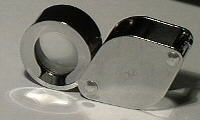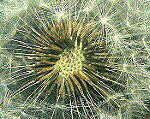![]() November 1995
November 1995
We all enjoy walks in the outdoors, whether it's the back garden, local park or a country walk. The aim of this monthly series is to add a new perspective to walks .... the close up world. There's an infinite variety of detail in nature which can be revealed with a 10X hand lens or under a low power microscope.
Each month seasonal aspects of nature in close up will be illustrated to encourage you to explore your own area. The author lives in Northern England so the topics inevitably reflect this!
There's no heavy biology (I hope) and they are written in the spirit and style of the Victorian microscopists and naturalists who wrote many books on this sort of theme, many which can be found in second-hand bookshops.
The author is an amateur naturalist and doesn't profess to be an expert. Books, courses and on-line resources where more in-depth information can be obtained are included in most monthly 'snapshots'.
In the first of this series a few tips on what and where to look for subjects to admire on a walk are given.
A change of perspective
 The aim of this series is simply to add a new
dimension to your existing walks, but it helps to pick walks
which are most likely show nature in it's infinite variety.
The aim of this series is simply to add a new
dimension to your existing walks, but it helps to pick walks
which are most likely show nature in it's infinite variety.
Even if you live in the most built up area, you may be surprised to find how many footpaths there are crossing areas of disused land, following stream banks, canals or quiet lanes. Almost any walk which passes small areas of woodland, unmanaged grassland, hedgerows and particularly wetland such as streams and ponds, can provide a wealth of plant and animal life for the microscopist.
I'm a great believer in discovering circular walks as short a distance as possible from where I live, because such local walks are those you are likely to do most often when you have the odd hour to spare. An excellent way in the UK of finding these is by buying the Ordnance Survey Pathfinder map for your area. For those unfamiliar with these maps, they are based on a large scale of 2.5 inches to the mile, and label footpaths and bridleways clearly in green. Small streams, ponds, woods etc are also shown. If you live outside of the UK, similar maps are probably available in your country.
What to take
 Before you put on your wellies and coat, what
should a microscopist or naturalist be carrying? Most amateur
naturalists wouldn't be without a pair of binoculars on a nature
walk, but how many carry a small hand lens (shown left)?
Before you put on your wellies and coat, what
should a microscopist or naturalist be carrying? Most amateur
naturalists wouldn't be without a pair of binoculars on a nature
walk, but how many carry a small hand lens (shown left)?
Low power microscopy is one of the most accessible and easiest forms of microscopy, and a hand lens (approx. 10X magnification) will provide a new insight into the wonderful detail visible in objects which are usually passed by without a second glance. The hand lens should not be confused with the 'Sherlock Holmes' type magnifying glass which only magnifies 2X or 3X, they're useful but using a hand lens at 8X-10X a wealth of detail becomes apparent. Hand lenses should be available from naturalist and microscopist suppliers and sometimes from High Street opticians.
A few small plastic bags or containers are also worth carrying to bring back small items. I find that the 35mm film cassettes are quite useful.
Seasonal objects to study
 At this time of year, most of the plants have
finished flowering, but don't overlook the seed heads of
plants, for example those in the daisy family (Compositae) as
an interesting subject for the hand lens. (The image left shows
the seed head of a dandelion which sets seed earlier in the
year). The fluffy heads of the thistles contain many small
seeds (achenes) attached to a feathery pappus. Pull a seed head
apart and examine the structure of each seed. You may be joined
in your search for seed heads by a noisy flock of goldfinches
(Carduelis carduelis), those delightful birds with red faces
and yellow wing- bars. They are particularly fond of thistle
seeds and other wild plant seeds for food.
At this time of year, most of the plants have
finished flowering, but don't overlook the seed heads of
plants, for example those in the daisy family (Compositae) as
an interesting subject for the hand lens. (The image left shows
the seed head of a dandelion which sets seed earlier in the
year). The fluffy heads of the thistles contain many small
seeds (achenes) attached to a feathery pappus. Pull a seed head
apart and examine the structure of each seed. You may be joined
in your search for seed heads by a noisy flock of goldfinches
(Carduelis carduelis), those delightful birds with red faces
and yellow wing- bars. They are particularly fond of thistle
seeds and other wild plant seeds for food.
The familiar Michaelmas Daisy (Aster novi-belgii) with it's purple daisy-like flowers should still be in flower on roadside verges, and provides the opportunity to examine the structure of the flower head. The flower head is not one flower, but a composite of many small flowers or florets. It's worth taking a Michaelmas Daisy flowerhead back with you to dissect and examine at home under a low power stereo microscope or hand lens. Your local library should have a number of books on wild flowers and botany which can explain the structure of these and other flowers.
Another plant with interesting seed heads is the Rosebay Willowherb (Epilobium angustifolium) which is a tall plant with pink flowers on a spike. It is found on almost all waste ground. When the long seed cases are ripe, the case explodes revealing the feathery seeds inside. Touching the end of a ripe seed case will often cause the case to open. Take back one of the unopened seed heads, and carefully open the case from the top. The way the seeds are initially tightly packed but rapidly unfurl is fascinating.
You may find the occasional dead butterfly such as the Red Admiral (Vanessa atalanta) on the path, and they are well worth taking back. The wing scales, antennae, legs and head can provide hours of fascinating study under a stereo or higher power microscope.
Other things to watch out for, are bird
feathers and strands of sheep wool or cattle hair entangled
in barbed wire fences. Try comparing the structure of the animal
hairs with those of your dog, cat or even your own hair. A higher
magnification (approx. 200X) using a traditional microscope will
be required to study animal hairs properly.
Return to Walk Index